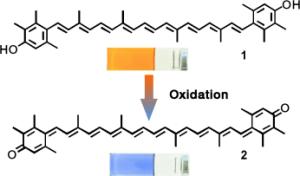|
Related Topics: |
|
|
|
Current News |
|
Chemistry A to Z |
|
About Internetchemistry |
Radical Scavengers in Red Smear Cheeses |
|
Carotenoids not only give carrots and red smear cheeses, such as Munster, Limburger, and Romadur, their characteristic red color, but they also protect organisms from oxidative stress. A research team headed by Hans-Dieter Martin and Wilhelm Stahl at the University of Düsseldorf has now synthesized and characterized one of these carotenoids in the lab. As they report in the journal Angewandte Chemie, this compound is characterized by outstanding antioxidative and photoprotective properties. |
|
Ranging in color from yellow to purple, carotenoids are pigments found throughout nature that act, among other things, as antioxidants. Antioxidants protect organisms from oxidative stress by capturing reactive oxygen species such as singlet oxygen and free radicals. Antioxidants are also added to foods, drugs, and plastics to prevent the oxidation of sensitive molecules. Brevibacterium linens, bacteria used for the production of red smear cheeses, contain 3,3’-dihydorxyisorenieratene (DHIR), a carotenoid with a unique structure. Carotenoids are made of a long hydrocarbon chain with alternating single and double bonds. In addition, DHIR has phenolic groups, aromatic six-membered rings of carbon atoms with an OH group, at either end of the chain. Phenolic compounds are also known to be antioxidants; for example, they are present in the tannins in tea and wine. By using a new synthetic route, the German research team was able to produce enough DHIR for the first comprehensive study of its properties. This revealed it to be an excellent antioxidant that beats other highly effective carotenoid antioxidants by a mile. In addition, its photoprotective properties are outstanding: DHIR protects cells from damage by UV radiation by absorbing UV light as well as capturing the free radicals produced by the radiation. These amazing antioxidative and photoprotective properties seem to stem from synergistic cooperation of the carotenoid and phenolic structural elements of DHIR. When scavenging free radicals, in some cases both of the phenolic groups are first oxidized to quinoid groups. The resulting quinoid carotenoid, which the researchers were also able to synthesize and characterize, is itself also a very strong antioxidant. Interestingly, it is blue and thus broadens the color palette attainable with carotenoids. Whether DHIR and its quinoid oxidation product can be used industrially as food and feed colorants, cosmetics, or antioxidants, is currently under investigation. These compounds may also be useful for the prevention of degenerative diseases related to free-radical damage, such as macular degeneration. |
|
|
|

